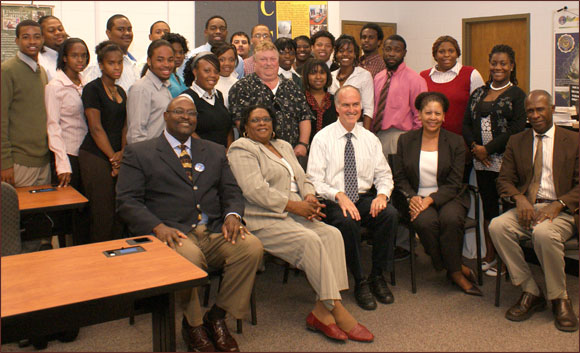|
|

Fall 2008 Distinguished Lecture Series - Gerald Benitz, PhD |
| October 7, 2008, Room 232, Dixon Hall |
The Center of Excellence in Remote Sensing Education and Research (CERSER) presented its 2008 Fall Distinguished Lecture Series with guest speaker Dr. Gerald Bernitz, Electrical Engineering, University of Wisconsin–Madison. Dr. Benitz spoke on the research being conducted at MIT Lincoln Laboratory and the opportunities for students. He then proceeded to present his research into Synthetic Aperture Radar (SAR) and the advances being made in Adaptive Signal Processing. His presentation was titled “Adaptive SAR Results with the LiMIT Testbed" and dealt with the formation of images and increasing their resolution through multiple signals versus larger antennas. Dr. Cynthia Warrick, Dean of the School of Mathematics, Science and Technology, closed the program and presented Dr. Bernitz with a certificate of appreciation. Dr. Bernitz’s presentation can be viewed here in Windows Media format (wmv).

Prior to the lecture, the IEEE-GRSS Northeastern North Carolina Chapter held its fall meeting. Chapter president, Dr. Linda Hayden, Assistant Dean of the School of Mathematics, Science and Technology welcomed local and visiting guests. The minutes from the February 2008 meeting were read by Mr. Jeff Wood, GRSS Chapter Secretary. Dr. Hayden presented the IGARSS 2008 Report followed by Dr. William Porter, GRSS Chapter Vice-President, who gave the ADCom Report. Mr. Je’aime Powell, president of the GRSS Student Chapter, led a meeting of the chapter presenting information on upcoming events and membership registration. |
| |
Adaptive SAR Results with the LiMIT Testbed
Gerald R. Benitz, PhD
Electrical Engineering University of Wisconsin–Madison
Adaptive phased-array radars promise significant performance enhancements for synthetic aperture radar (SAR). One obvious application is to provide electronic protection (EP) against interference. Another application is to mitigate range and/or Doppler ambiguities, thereby potentially enabling multiple simultaneous modes of operation, increased area rates, and higher-resolution scan modes.
Presented here are adaptive processing results from the Lincoln Multi-mission ISR Testbed (LiMIT) developed by MIT Lincoln Laboratory in 2004. The system is an 8-channel X-band radar installed on a Boeing 707. Initial flight tests employed a 180 MHz waveform and digitally recorded spotlight SAR mode collections. Collections at Ft. Huachuca in July 2004 included wideband interference sources. EP results demonstrate SAR image recovery via adaptive processing, with improvements in signal-to-interference ratio exceeding 30 dB for a near-main-beam interferer. Mitigation approaches include derivative-based updating in the frequency domain and multiple time-taps in the image domain. The impact on image quality is minimal. Doppler ambiguity mitigation is demonstrated by producing an image from the transmit beam sidelobes. The sidelobe region has Doppler frequencies that are ambiguous with the main lobe region, and only adaptive beam steering can recover this energy. One image result shows recovery of a scene with 6 kHz clutter bandwidth, but from a data collection using only a 2 kHz pulse rate. |
| |
|
| |
Center of Excellence in Remote Sensing Education and Research (CERSER)
NSF CI-Team Award # OCI-0636361, CReSIS Subcontract #FY2005-108C
1704 Weeksville Road, Box 672, Elizabeth City, North Carolina 27909
Phone (252) 335-3696 Fax (252) 335-3790
Elizabeth City State University does not endorse, sponsor or provide material located on this site. |
| |
|
|

